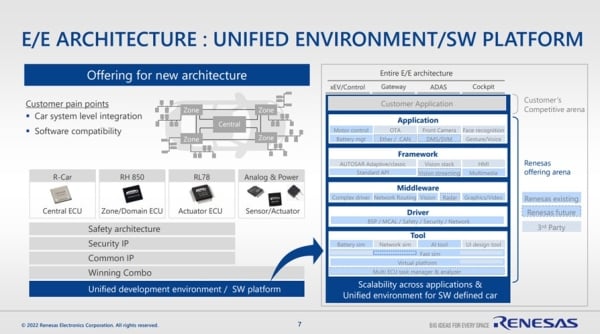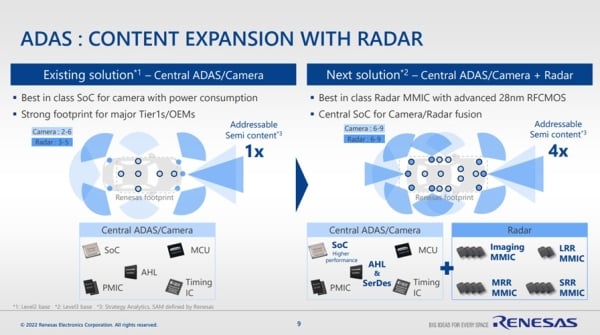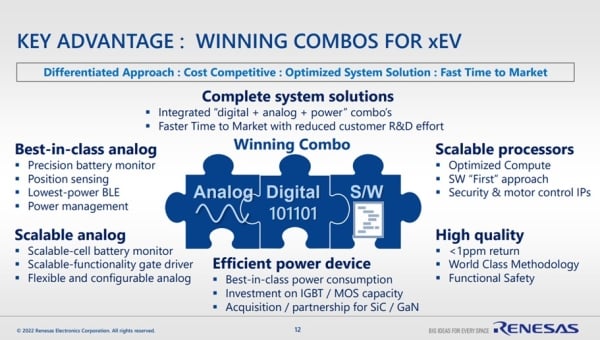In recent years, the automotive industry has seen the acceleration of trends such as automated driving and electrification and the traditional human-driven gasoline-powered vehicle is undergoing a major transformation. The key player that will realize this once-in-100-years transformation of automotive is nothing but semiconductors.
On March 3, Renesas held an Analyst Day where Takeshi Kataoka, Senior Vice President, General Manager of Automotive Solution Business Unit, and Vivek Bhan, Senior Vice President, Deputy General Manager of Automotive Solution Business Unit, presented the future strategy of Renesas' automotive business. This blog explains how Renesas will implement its growth strategy to capture the future automotive market trends.
Engagement to Emerging Customers and Emerging Regions
Our automotive semiconductor business has traditionally been centered on business for relatively larger Tier1/OEM customers mainly in Japan, Europe, and the U.S. In recent years, however, with the accelerating shift from conventional gasoline vehicles to electric vehicles (xEV), many new vehicle manufacturers have emerged in regions such as China, India, and Southeast Asia. This change of automotive landscape has been affecting our business. Our Design-In from emerging customers and regions has tripled over 2019-2021, and we see capturing new business from these customers and regions more aggressively as one of the pillars in our future business growth strategy.
As a key driver to win business from emerging customers and regions, we will focus on offering a set solution called Winning Combos, which combines our digital, analog, and power products. Instead of using stand-alone products, these system-level optimized set solutions can easily solve unique automotive challenges such as functional safety and power efficiency, and help customers reduce development costs and man-hours. Emerging customers in the automotive industry will benefit greatly from this Winning Combo solution strategy since they can speed up the time from product planning to market launch. Last year, we launched a new organization to engage these emerging customers and regions and we will strive to win new business with greater speed in the future.
Focus Segments
As previously mentioned, new technologies such as automated driving and electric vehicles are revolutionizing the way automobiles are manufactured and driven today. To enable these new technologies, the electrical/electronic (E/E) architecture inside vehicles is undergoing a revolution. (For more on the evolution of E/E architecture, see this article.)
Amid these changes in the automotive industry, we are focusing on three key areas: (1) E/E architecture, (2) automated driving, and (3) electric vehicles, and developing solutions to solve our customers' design challenges.
E/E architecture
As the traditional architecture where ECUs are highly distributed evolves to more domain-centralized architecture, customers are faced with the need to design and develop entire systems rather than optimizing individual ECUs.
With our broad product portfolio, which includes MCUs, SoCs, as well as analog and power products, we can support the entire E/E architecture, from Central ECUs to Zone ECUs and actuators. In addition, our IP is common across products to ensure software reusability and scalability for our customers.
In addition, we expand our software to provide a unified development environment across multiple ECUs, rather than ECU-by-ECU development as in previous generations. This unified development allows customers to concentrate on the development of applications that they wish to differentiate.
Our Design-In in the field of E/E architecture has more than doubled between 2019 and 2021, and we aim to further expand our business in this field in the future.
ADAS
Renesas has been providing solutions for Central ADAS, which bundles ADAS domains, and cameras to major Tier1 and OEM customers in both Japan and overseas by offering low-power SoCs (R-Car), MCUs (RH850), and analog products such as power management ICs and AHL (Automotive High-definition Link).
In addition to these products, the acquisition of IDT in 2019 expanded our MMICs for radar with low power consumption and low noise, using 28nm RF-CMOS, the industry's most advanced RF process. This enables us to offer a total fusion solution in the ADAS field that includes radar in addition to the existing Central ADAS and cameras.
With this expansion of our product portfolio, we expect our sales growth to exceed the market growth rate.
xEV
In the xEV field as well, we will deploy analog products that have been expanded through recent acquisitions and strive to capture the growing market with leading features such as high accuracy performance in BMS (Battery Management System) and scalability to support a wide variety of battery cell counts. In addition, the Winning Combo of BMICS and MCUs, which have been one of our traditional strengths, supports advanced functional safety that meets ASIL-D and will contribute to the reduction of customers' development costs.
In addition, we are accelerating investment in power products, expanding production capacity for IGBTs and MOS, and leveraging external partnerships to provide power products made of silicon carbide (SiC), a compound semiconductor material with higher power efficiency than conventional silicon (Si).
Our Design-In in the xEV sector has quadrupled from 2019 to 2021, and we aim to further expand our presence in this market.
For more information on our automotive solutions, please visit our Solutions page or our Winning Combo page.



